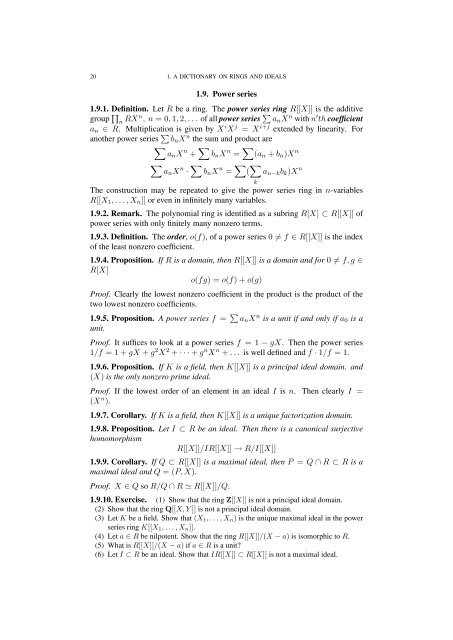Commutative algebra - Department of Mathematical Sciences - old ...
Commutative algebra - Department of Mathematical Sciences - old ...
Commutative algebra - Department of Mathematical Sciences - old ...
You also want an ePaper? Increase the reach of your titles
YUMPU automatically turns print PDFs into web optimized ePapers that Google loves.
20 1. A DICTIONARY ON RINGS AND IDEALS<br />
1.9. Power series<br />
1.9.1. Definition. Let R be a ring. The power series ring R[[X]] is the additive<br />
group <br />
n RXn , n = 0, 1, 2, . . . <strong>of</strong> all power series anX n with n ′ th coefficient<br />
an ∈ R. Multiplication is given by X i X j = X i+j extended by linearity. For<br />
another power series bnX n the sum and product are<br />
anX n + bnX n = (an + bn)X n<br />
anX n · bnX n = ( <br />
k<br />
an−kbk)X n<br />
The construction may be repeated to give the power series ring in n-variables<br />
R[[X1, . . . , Xn]] or even in infinitely many variables.<br />
1.9.2. Remark. The polynomial ring is identified as a subring R[X] ⊂ R[[X]] <strong>of</strong><br />
power series with only finitely many nonzero terms.<br />
1.9.3. Definition. The order, o(f), <strong>of</strong> a power series 0 = f ∈ R[[X]] is the index<br />
<strong>of</strong> the least nonzero coefficient.<br />
1.9.4. Proposition. If R is a domain, then R[[X]] is a domain and for 0 = f, g ∈<br />
R[X]<br />
o(fg) = o(f) + o(g)<br />
Pro<strong>of</strong>. Clearly the lowest nonzero coefficient in the product is the product <strong>of</strong> the<br />
two lowest nonzero coefficients.<br />
1.9.5. Proposition. A power series f = anX n is a unit if and only if a0 is a<br />
unit.<br />
Pro<strong>of</strong>. It suffices to look at a power series f = 1 − gX. Then the power series<br />
1/f = 1 + gX + g 2 X 2 + · · · + g n X n + . . . is well defined and f · 1/f = 1.<br />
1.9.6. Proposition. If K is a field, then K[[X]] is a principal ideal domain. and<br />
(X) is the only nonzero prime ideal.<br />
Pro<strong>of</strong>. If the lowest order <strong>of</strong> an element in an ideal I is n. Then clearly I =<br />
(X n ).<br />
1.9.7. Corollary. If K is a field, then K[[X]] is a unique factorization domain.<br />
1.9.8. Proposition. Let I ⊂ R be an ideal. Then there is a canonical surjective<br />
homomorphism<br />
R[[X]]/IR[[X]] → R/I[[X]]<br />
1.9.9. Corollary. If Q ⊂ R[[X]] is a maximal ideal, then P = Q ∩ R ⊂ R is a<br />
maximal ideal and Q = (P, X).<br />
Pro<strong>of</strong>. X ∈ Q so R/Q ∩ R R[[X]]/Q.<br />
1.9.10. Exercise. (1) Show that the ring Z[[X]] is not a principal ideal domain.<br />
(2) Show that the ring Q[[X, Y ]] is not a principal ideal domain.<br />
(3) Let K be a field. Show that (X1, . . . , Xn) is the unique maximal ideal in the power<br />
series ring K[[X1, . . . , Xn]].<br />
(4) Let a ∈ R be nilpotent. Show that the ring R[[X]]/(X − a) is isomorphic to R.<br />
(5) What is R[[X]]/(X − a) if a ∈ R is a unit?<br />
(6) Let I ⊂ R be an ideal. Show that IR[[X]] ⊂ R[[X]] is not a maximal ideal.
















